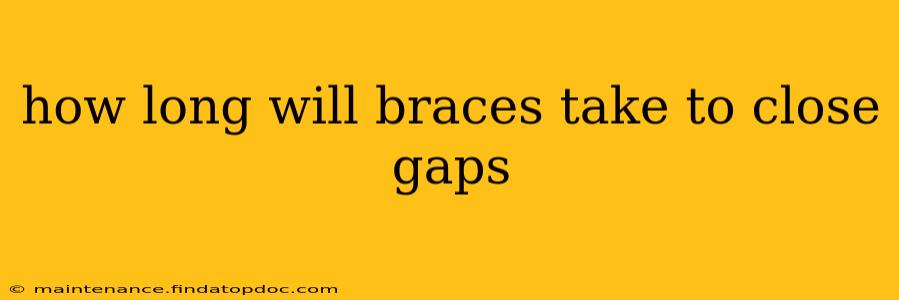Closing gaps in your teeth with braces is a common orthodontic procedure, but the timeline varies significantly depending on several factors. There's no one-size-fits-all answer, but understanding these influencing elements will give you a better idea of what to expect. This guide will delve into the factors affecting treatment duration and answer some frequently asked questions.
What Factors Determine Treatment Time for Gap Closure?
Several interconnected factors influence how long it takes to close gaps with braces:
-
Severity of the gap: Smaller gaps naturally require less time to close than larger ones. A minor spacing issue might be resolved within a few months, while significant gaps could necessitate a year or more.
-
Overall dental health: Pre-existing conditions like gum disease or cavities need to be addressed before orthodontic treatment begins. These issues can impact treatment duration and overall success.
-
Patient cooperation: Diligent adherence to the orthodontist's instructions, including wearing elastics as prescribed and maintaining excellent oral hygiene, is crucial for efficient treatment. Non-compliance can prolong treatment time.
-
Age of the patient: Younger patients often respond more readily to orthodontic treatment than older adults, potentially leading to faster gap closure.
-
Type of braces: While the underlying mechanics are similar, different types of braces (traditional metal braces, ceramic braces, Invisalign aligners) can have slightly different treatment timelines. This difference is usually minimal, but it can exist.
-
Bone density and growth: The rate at which your bone remodels influences how quickly teeth move into their correct positions. Individuals with denser bone might experience a slightly slower treatment time.
-
Orthodontist's expertise and technique: An experienced orthodontist will utilize the most efficient techniques and technologies to minimize treatment duration.
How Long Does it Typically Take?
While precise prediction is impossible without a professional assessment, a reasonable estimate for closing gaps with braces ranges from 6 months to 24 months (or even longer in complex cases). Most patients fall within this range, but individual circumstances drastically alter the timeframe.
What if I Have Multiple Gaps?
Multiple gaps significantly increase the treatment time. The orthodontist must address each gap strategically, coordinating tooth movement to ensure an aesthetically pleasing and functionally sound outcome. Expect a longer treatment period if you have more than one gap to close.
What if My Gap is Caused by a Missing Tooth?
A gap caused by a missing tooth presents a more complex situation. Treatment may involve placing an implant, bridge, or partial denture before or after orthodontic treatment. This adds considerable time to the overall process.
Can I Speed Up the Process?
While you can't magically accelerate the process, consistent cooperation with your orthodontist is key. This includes meticulous oral hygiene, wearing elastics as directed, and attending all scheduled appointments.
What Happens After the Gaps Are Closed?
Once the gaps are closed, the braces will remain in place for a period of retention to stabilize the teeth in their new positions. This retention phase involves wearing a retainer, either removable or fixed, to prevent the teeth from shifting back. The length of the retention phase is usually at least as long as the active treatment time, and often longer.
Disclaimer: This information is for general knowledge and does not constitute medical advice. Consult with a qualified orthodontist for personalized assessment and treatment planning. Only a professional can accurately assess your individual situation and provide a realistic estimate for your treatment timeline.
